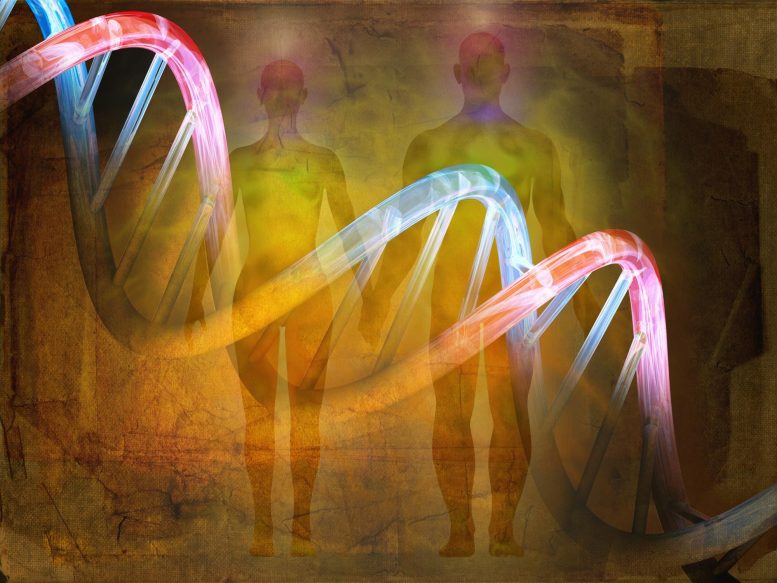
Dartmouth researchers propose that the ability of humans to freely move their shoulders and elbows, aiding in activities like reaching or throwing, originated as a natural braking system for primate ancestors descending from trees. Through an analysis of climbing techniques and limb structures in chimps and mangabeys, they found that the unique limb flexibility in apes and early humans allowed them to descend safely, a trait that eventually facilitated evolutionary advancements in tool use and hunting techniques.
Research suggests that ‘downclimbing’ from trees played a pivotal role in early human evolution.
The mobility in human shoulders and the flexibility of our elbows, which enable actions like reaching high shelves or throwing a ball, may have originally developed as a safety mechanism for our primate ancestors descending from trees.
A study by Dartmouth researchers, published in the journal Royal Society Open Science, suggests that apes and early humans likely developed these mobile joints to regulate their speed when descending from trees due to the pull of gravity on their weightier frames. As early humans transitioned from forests to savannas, these adaptable limbs proved crucial for tasks such as food collection and the use of tools for hunting and protection.
The researchers used sports-analysis and statistical software to compare videos and still-frames they took of chimpanzees and small monkeys called mangabeys climbing in the wild. They found that chimps and mangabeys scaled trees similarly, with shoulders and elbows mostly bent close to the body. When climbing down, however, chimpanzees extended their arms above their heads to hold onto branches like a person going down a ladder as their greater weight pulled them downward rump-first.
Luke Fannin, first author of the study and a graduate student in Dartmouth’s Ecology, Evolution, Environment, and Society program, said the findings are among the first to identify the significance of “downclimbing” in the evolution of apes and early humans, which are more genetically related to each other than to monkeys. Existing research has observed chimps ascending and navigating trees—usually in experimental setups—but the researchers’ extensive video from the wild allowed them to examine how the animals’ bodies adapted to climbing down, Fannin said.
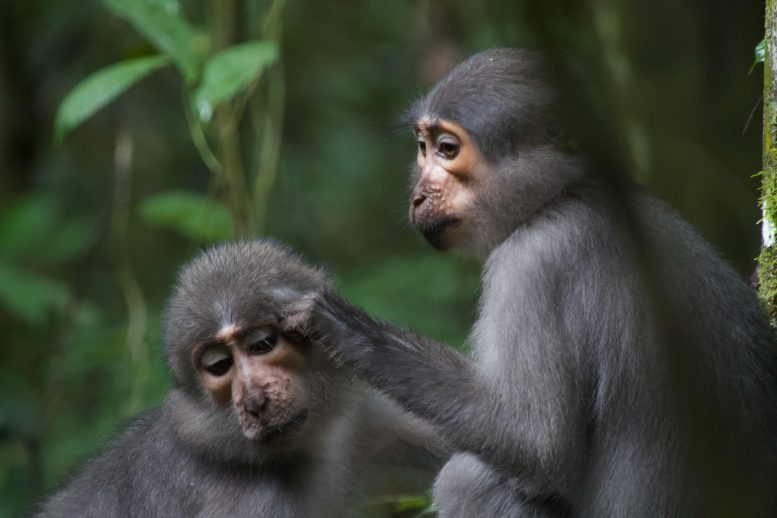
Dartmouth researchers report that apes and early humans evolved more flexible shoulders and elbows than monkeys (above) to safely get out of trees. For early humans, these versatile appendages would have been essential for gathering food and deploying tools for hunting and defense. Credit: Luke Fannin, Dartmouth
“Our study broaches the idea of downclimbing as an undervalued, yet incredibly important factor in the diverging anatomical differences between monkeys and apes that would eventually manifest in humans,” Fannin said. “Downclimbing represented such a significant physical challenge given the size of apes and early humans that their morphology would have responded through natural selection because of the risk of falls.”
“Our field has thought about apes climbing up trees for a long time—what was essentially absent from the literature was any focus on them getting out of a tree. We’ve been ignoring the second half of this behavior,” said study co-author Jeremy DeSilva, professor and chair of anthropology at Dartmouth.
“The first apes evolved 20 million years ago in the kind of dispersed forests where they would go up a tree to get their food, then come back down to move on to the next tree,” DeSilva said.
“Getting out of a tree presents all kinds of new challenges. Big apes can’t afford to fall because it could kill or badly injure them. Natural selection would have favored those anatomies that allowed them to descend safely.”
Flexible shoulders and elbows passed on from ancestral apes would have allowed early humans such as Australopithecus to climb trees at night for safety and come down in the daylight unscathed, DeSilva said. Once Homo erectus could use fire to protect itself from nocturnal predators, the human form took on broader shoulders capable of a 90-degree angle that—combined with free-moving shoulders and elbows—made our ancestors excellent shots with a spear (apes cannot throw accurately).
“It’s that same early-ape anatomy with a couple of tweaks. Now you have something that can throw a spear or rocks to protect itself from being eaten or to kill things to eat for itself. That’s what evolution does—it’s a great tinkerer,” DeSilva said.
“Climbing down out of a tree set the anatomical stage for something that evolved millions of years later,” he said. “When an NFL quarterback throws a football, that movement is all thanks to our ape ancestors.”
Despite chimps’ lack of grace, Fannin said, their arms have adapted to ensure the animals reach the ground safely—and their limbs are remarkably similar to those of modern humans.
“It’s the template that we came from—going down was probably far more of a challenge for our early ancestors, too,” Fannin said. “Even once humans became upright, the ability to ascend, then descend, a tree would’ve been incredibly useful for safety and nourishment, which is the name of the game when it comes to survival. We’re modified, but the hallmarks of our ape ancestry remain in our modern skeletons.”
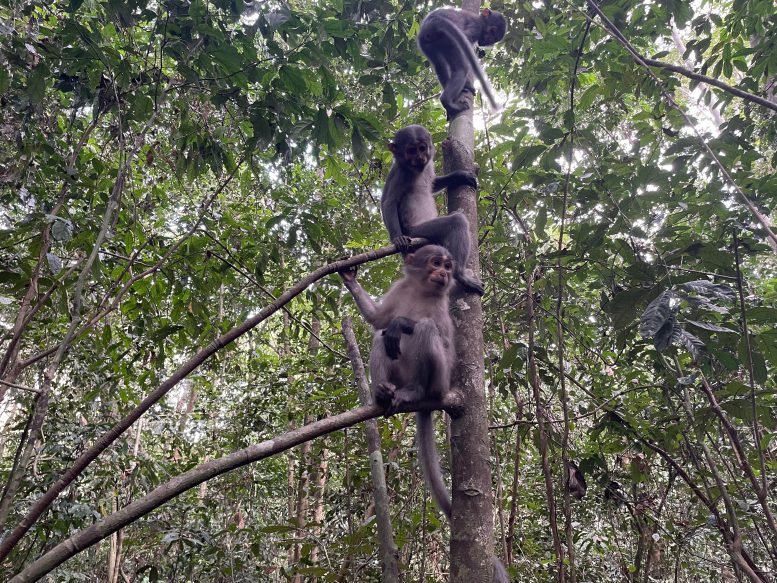
The researchers used sports-analysis software to compare the climbing movements of chimpanzees and mangabeys (pictured). They found that chimps support their greater weight when climbing down by fully extending their arms above their heads thanks to shallow, rounded shoulder joints and shortened elbow bones that are similar to those in humans. Mangabeys, which are built more like cats or dogs, have less flexibility and position their shoulders and elbows roughly the same when climbing up or down. Credit: Luke Fannin, Dartmouth
The researchers also studied the anatomical structure of chimp and mangabey arms using skeletal collections at Harvard University and The Ohio State University, respectively. Like people, chimps have a shallow ball-and-socket shoulder that—while more easily dislocated—allows for a greater range of movement, Fannin said. And like humans, chimps can fully extend their arms thanks to the reduced length of the bone just behind the elbow known as the olecranon process.
Mangabeys and other monkeys are built more like quadrupedal animals such as cats and dogs, with deep pear-shaped shoulder sockets and elbows with a protruding olecranon process that makes the joint resemble the letter L. While these joints are more stable, they have a much more limited flexibility and range of movement.
The researchers’ analysis showed that the angle of a chimp’s shoulders was 14 degrees greater during descent than when climbing up. And their arm extended outward at the elbow 34 degrees more when coming down from a tree than going up. The angles at which mangabeys positioned their shoulders and elbows were only marginally different—4 degrees or less—when they were ascending a tree versus downclimbing.
“If cats could talk, they would tell you that climbing down is trickier than climbing up and many human rock climbers would agree. But the question is why is it so hard,” said study co-author Nathaniel Dominy, the Charles Hansen Professor of Anthropology and Fannin’s adviser.
“The reason is that you’re not only resisting the pull of gravity, but you also have to decelerate,” Dominy said. “Our study is important for tackling a theoretical problem with formal measurements of how wild primates climb up and down. We found important differences between monkeys and chimpanzees that may explain why the shoulders and elbows of apes evolved greater flexibility.”
Co-author Mary Joy, who led the study with Fannin for her undergraduate thesis and graduated from Dartmouth in 2021, was reviewing videos of chimps that DeSilva had filmed when she noticed the difference in how the animals descended trees than how they went up them.
“It was very erratic, just crashing down, everything’s flying. It’s very much a controlled fall,” Joy said. “In the end, we concluded that the way chimps descend a tree is likely related to weight. Greater momentum potentially expends less energy and they’re much more likely to reach the ground safely than by making small, restricted movements.”
But as a trail runner, Joy knew the pained feeling of inching down an incline in short clips instead of just hurtling down the path with the pull of gravity, her legs extended forward to catch her at the end of each stride.
“When I’m moving downhill, the slower I’m going and restricting my movement, the more I’m fatiguing. It catches up to me very quickly. No one would think the speed and abandon with which chimps climb down from trees would be the preferred method for a heavier primate, but my experience tells me it’s more energy efficient,” she said.
“Movement in humans is a masterpiece of evolutionary compromises,” Joy said. “This increased range of motion that began in apes ended up being pretty good for us. What would the advantage of losing that be? If evolution selected for people with less range of motion, what advantages would that confer? I can’t see any advantage to losing that.”
Reference: “Downclimbing and the evolution of ape forelimb morphologies” by Luke D. Fannin, Mary S. Joy, Nathaniel J. Dominy, W. Scott McGraw and Jeremy M. DeSilva, 6 September 2023, Royal Society Open Science.
DOI: 10.1098/rsos.230145
This work was supported by the National Science Foundation, the Clare Garber Goodman Fund and the James O. Freedman Presidential Scholars Research Fund at Dartmouth, a Mamont Scholars Grant from The Explorers Club, the Leakey Foundation, and the Primate Society of Great Britain.

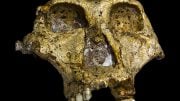
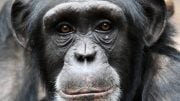


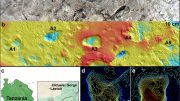

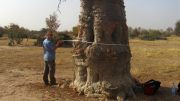

Be the first to comment on "“Downclimbing” – The Hidden Evolutionary Force Behind Human Anatomy"